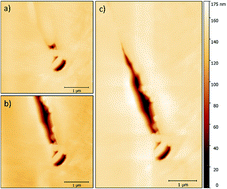当前位置:
X-MOL 学术
›
Faraday Discuss.
›
论文详情
Our official English website, www.x-mol.net, welcomes your
feedback! (Note: you will need to create a separate account there.)
A study of dynamic nanoscale corrosion initiation events using HS-AFM
Faraday Discussions ( IF 3.3 ) Pub Date : 2018-04-16 , DOI: 10.1039/c8fd00017d Stacy Moore 1, 2, 3, 4, 5 , Robert Burrows 5, 6, 7 , Loren Picco 1, 2, 3, 4, 5 , Tomas L. Martin 1, 2, 3, 4, 5 , Scott J. Greenwell 1, 2, 3, 4, 5 , Thomas B. Scott 1, 2, 3, 4, 5 , Oliver D. Payton 1, 2, 3, 4, 5
Faraday Discussions ( IF 3.3 ) Pub Date : 2018-04-16 , DOI: 10.1039/c8fd00017d Stacy Moore 1, 2, 3, 4, 5 , Robert Burrows 5, 6, 7 , Loren Picco 1, 2, 3, 4, 5 , Tomas L. Martin 1, 2, 3, 4, 5 , Scott J. Greenwell 1, 2, 3, 4, 5 , Thomas B. Scott 1, 2, 3, 4, 5 , Oliver D. Payton 1, 2, 3, 4, 5
Affiliation

|
Atomic force microscopes (AFMs) are capable of high-resolution mapping of structures and the measurement of mechanical properties on nanometre scales within gaseous, liquid and vacuum environments. The contact mode high-speed AFM (HS-AFM) developed at Bristol Nano Dynamics Ltd. operates at speeds that are orders of magnitude faster than conventional AFMs, and is capable of capturing multiple frames per second. This allows for direct observation of dynamic events in real-time, with nanometre lateral resolution and subatomic height resolution. HS-AFM is a valuable tool for the imaging of nanoscale corrosion initiation events, such as metastable pitting, grain boundary (GB) dissolution and short crack formation during stress corrosion cracking (SCC). Within this study HS-AFM was combined with SEM and FIB milling to produce a multifaceted picture of localised corrosion events occurring on thermally sensitised AISI 304 stainless steel in an aqueous solution of 1% sodium chloride (NaCl). HS-AFM measurements were performed in situ by imaging within a custom built liquid cell with parallel electrochemical control. The high resolution of the HS-AFM allowed for measurements to be performed at individual reaction sites, i.e. at specific GB carbide surfaces. Topographic maps of the sample surface allowed for accurate measurements of the dimensions of pits formed. Using these measurements it was possible to calculate, and subsequently model, the volumes of metal reacting with respect to time, and so the current densities and ionic fluxes at work. In this manner, the local electrochemistry at nanoscale reaction sites may be reconstructed.
中文翻译:

使用HS-AFM研究动态纳米级腐蚀引发事件
原子力显微镜(AFM)能够在气体,液体和真空环境中以纳米级对结构进行高分辨率绘制,并能够测量纳米级的机械性能。由Bristol Nano Dynamics Ltd.开发的接触模式高速AFM(HS-AFM)以比传统AFM快几个数量级的速度运行,并且能够每秒捕获多个帧。这允许以纳米横向分辨率和亚原子高度分辨率实时实时观察动态事件。HS-AFM是用于成像纳米级腐蚀引发事件(例如亚稳态点蚀,晶界(GB)溶解和应力腐蚀裂纹(SCC)期间短裂纹形成)的有价值的工具。在这项研究中,HS-AFM与SEM和FIB铣削相结合,以产生多方面的图像,显示在1%氯化钠(NaCl)水溶液中的热敏AISI 304不锈钢上发生的局部腐蚀事件。进行HS-AFM测量通过使用并行电化学控制在定制的液体池中进行成像来原位成像。HS-AFM的高分辨率允许在单个反应部位(即特定的GB碳化物表面)进行测量。样品表面的地形图可以精确测量形成的凹坑的尺寸。使用这些测量结果,可以计算出金属的体积,并随后对其建模,从而计算出工作时的电流密度和离子通量。以这种方式,可以重建纳米级反应位点的局部电化学。
更新日期:2018-10-10
中文翻译:

使用HS-AFM研究动态纳米级腐蚀引发事件
原子力显微镜(AFM)能够在气体,液体和真空环境中以纳米级对结构进行高分辨率绘制,并能够测量纳米级的机械性能。由Bristol Nano Dynamics Ltd.开发的接触模式高速AFM(HS-AFM)以比传统AFM快几个数量级的速度运行,并且能够每秒捕获多个帧。这允许以纳米横向分辨率和亚原子高度分辨率实时实时观察动态事件。HS-AFM是用于成像纳米级腐蚀引发事件(例如亚稳态点蚀,晶界(GB)溶解和应力腐蚀裂纹(SCC)期间短裂纹形成)的有价值的工具。在这项研究中,HS-AFM与SEM和FIB铣削相结合,以产生多方面的图像,显示在1%氯化钠(NaCl)水溶液中的热敏AISI 304不锈钢上发生的局部腐蚀事件。进行HS-AFM测量通过使用并行电化学控制在定制的液体池中进行成像来原位成像。HS-AFM的高分辨率允许在单个反应部位(即特定的GB碳化物表面)进行测量。样品表面的地形图可以精确测量形成的凹坑的尺寸。使用这些测量结果,可以计算出金属的体积,并随后对其建模,从而计算出工作时的电流密度和离子通量。以这种方式,可以重建纳米级反应位点的局部电化学。











































 京公网安备 11010802027423号
京公网安备 11010802027423号